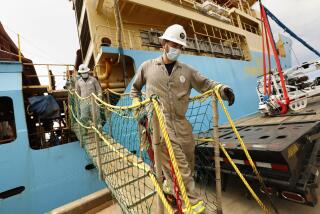DDT Deposit on Sea Floor
- Share via
* I was dismayed by “Sea Floor DDT Cleanup Would Pose Huge Problems” (Aug. 10). The article relies on “Chicken Little” proclamations from quasi-scientists and bureaucrats intent on expanding their imperialistic domain.
The fact is that 93% of all DDT in seawater is broken down in 38 days. If the bureaucrats and hard core-environmentalists want to spend $235 million to $1 billion on this type of unnecessary boondoggle let them administer and pay for it themselves, not with taxpayer money.
The facts on DDT are: Not one Allied soldier during World War II contacted typhus, as the result of the protective use of DDT. There was a dramatic decrease in those stricken with malaria, as a result of the use of DDT to control mosquitoes.
There is no connection of DDT to thin bird eggshells. This is a phenomenon that was known for decades before the use of DDT. There is no data that shows DDT is a carcinogen or health hazard of any kind to the human race.
CLIFF DOUBEK, PE
Anaheim
* The missing equation in the discussion of the ecological problems (and the proposed solutions thereto) caused by the persistent DDT/DDE plume in the sediments off Palos Verdes is that the natural sedimentation process that would facilitate capping the sediments has been drastically altered by development, concrete channeling and other “flood control” measures that have occurred throughout the Southland. The L.A. County Sanitation District still offers the absurd proposal that by continuing to be allowed to dump sewage that receives only primary treatment, and is thus so voluminous and contaminated that it does not meet federal standards for near-shore disposal, they offer the best means of capping the contaminated deposits!
At the same time, we hear proposals to raise dikes along or even concrete-line the remaining natural portions of the L.A. River, reduce the area of wetlands adjacent to Ballona Creek with massive development, and make various other alterations along our streams, rivers and coastline that reduce the natural sources of near-shore marine sedimentation. By carefully restoring the L.A. River, Ballona Creek and other natural sources of sediments to a more natural state and protecting and enhancing the less than 10% of coastal wetlands remaining in Southern California, we will not only perform a valuable ecological service at those sites, improve coastal fisheries, and reduce offshore pollution and the risk of flooding of low-lying areas, but we will also allow relatively unpolluted sediments to resupply our beautiful beaches and, at the same time, increase the rate at which DDT-contaminated sediments are buried.
MARTIN J. BYHOWER
Redondo Beach
More to Read
Sign up for Essential California
The most important California stories and recommendations in your inbox every morning.
You may occasionally receive promotional content from the Los Angeles Times.













